| ________________
CM . . .
. Volume XV Number 22. . . .June 26, 2009 
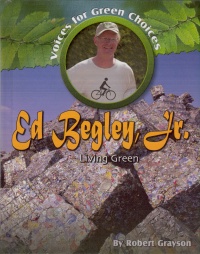 |
Ed. Begley, Jr.: Living Green. (Voices for Green Choices).
Robert Grayson.
St. Catharines, ON: Crabtree, 2009.
48pp., pbk. & hc., $11.95 (pbk.), $21.56 (hc.).
ISBN 978-0-7787-4680-5 (pbk.), ISBN 978-0-7787-4667-6 (hc.).
Subject Headings:
Begley, Ed-Juvenile literature.
Green movement-Juvenile literature.
Sustainable living-Juvenile literature.
Environmentalists-United States-Biography-Juvenile literature.
Grades 4-7 / Ages 9-12.
Review by Gail Hamilton.
*** /4
|
| |
|
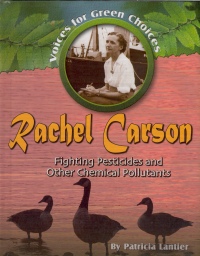 |
Rachel Carson: Fighting Pesticides and Other Chemical Pollutants. (Voices for Green Choices).
Patricia Lantier.
St. Catharines, ON: Crabtree, 2009.
48pp., pbk. & hc., $11.95 (pbk.), $21.56 (hc.).
ISBN 978-0-7787-4676-8 (pbk.), ISBN 978-0-7787-4663-8 (hc.).
Subject Headings:
Carson, Rachel, 1907-1964-Juvenile literature.
Biologists-United States-Biography-Juvenile literature.
Environmentalists-United States-Biography-Juvenile literature.
Grades 4-7 / Ages 9-12.
Review by Gail Hamilton.
*** /4
|
| |
|
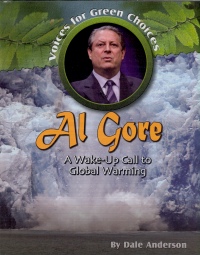 |
Al Gore: A Wake-Up Call to Global Warming. (Voices for Green Choices).
Dale Anderson.
St. Catharines, ON: Crabtree, 2009.
48pp., pbk. & hc., $11.95 (pbk.), $21.56 (hc.).
ISBN 978-0-7787-4679-9 (pbk.), ISBN 978-0-7787-4666-0 (hc.).
Subject Headings:
Gore, Albert, 1948- –Juvenile literature.
Environmentalists-United States-Biography-Juvenile literature.
Global warming-Juvenile literature.
Grades 4-7 / Ages 9-12.
Review by Gail Hamilton.
*** /4
|
| |
|
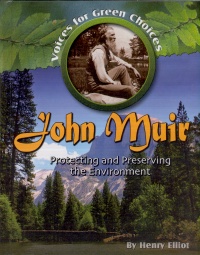 |
John Muir: Protecting and Preserving the Environment. (Voices for Green Choices).
Henry Elliot.
St. Catharines, ON: Crabtree, 2009.
48ppp., pbk. & hc., $11.95 (pbk.), $21.56 (hc.).
ISBN 978-0-7787-4681-2 (pbk.), ISBN 978-0-7787-4668-3 (hc.).
Subject Headings:
Muir, John, 1838-1914–Juvenile literature.
Naturalists-United States-Biography-Juvenile literature.
Conservationists-United States-Biography-Juvenile literature.
Environmentalists-United States-Biography-Juvenile literature.
Grades 4-7 / Ages 9-12.
Review by Gail Hamilton.
*** /4
|
| |
|
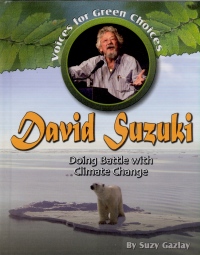 |
David Suzuki: Doing Battle with Climate Change. (Voices for Green Choices).
Suzy Gazlay.
St. Catharines, ON: Crabtree, 2009.
48pp., pbk. & hc., $11.95 (pbk.), $21.56 (hc.).
ISBN 978-0-7787-4678-2 (pbk.), ISBN 978-0-7787-4665-2 (hc.).
Subject Headings:
Suzuki, David, 1936–Juvenile literature.
Global warming-Juvenile literature.
Climate changes-Juvenile literature.
Environmentalists-Canada-Biography-Juvenile literature.
Broadcasters-Canada-Biography-Juvenile literature.
Grades 4-7 / Ages 9-12.
Review by Gail Hamilton.
*** /4
|
| |
|
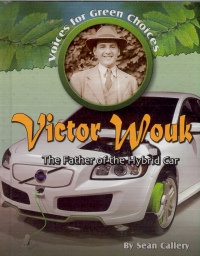 |
Victor Wouk: The Father of the Hybrid Car. (Voices for Green Choices).
Sean Callery.
St. Catharines, ON: Crabtree, 2009.
48pp., pbk. & hc., $11.95 (pbk.), $21.56 (hc.).
ISBN 978-0-7787-4677-5 (pbk.), ISBN 978-0-7787-4664-5 (hc.).
Subject Headings:
Wouk, Victor, 1919-2005–Juvenile literature.
Hybrid electric cars-Juvenile literature.
Automobile engineers-United States-Biography-Juvenile literature.
Grades 4-7 / Ages 9-12.
Review by Gail Hamilton.
*** /4
|
| |
|

excerpt:
David often uses real world examples to illustrate his message. Once, on a smoggy day, he took a film crew to a hospital emergency room. There they filmed numerous children and elderly people who were seeking treatment for severe breathing problems. Many of the patients had been driven there in SUVs, thereby contributing to their own medical problems. David explained that they were so used to living in a world with serious environmental issues that it didn't occur to them that their lifestyle was connected to their illnesses. (From David Suzuki: Doing Battle with Climate Change).
It seems these days that one cannot watch a television newscast or open a daily newspaper without seeing a piece about the global crisis facing Earth's environment- diminishing fossil fuels, the melting of the polar ice cap, the polluting of the ocean and the extinction of several animal and plant species due to the loss of certain habitats. The new "Voices for Green Choices" series introduces readers to six champions of the environment who have fought for a "greener" Earth. Each title provides a biographical portrait of an environmentalist and includes information about his or her childhood, education, work experience, adult life, awards and honours, and, most importantly, his or her efforts related to ecological issues. There are sidebars with additional facts and, occasionally, quotes from the featured person. A table of contents, a glossary, an index, a chronology and a list of books and web sites for further study are also provided.
The text is printed on white, dark blue (like the Earth) and pale green backgrounds (green being suitable for the environmental focus of the series). There is plenty of interesting information, suitable both for the casual reader and for the student who is doing a research project, but only about one-fifth of each title is actually devoted to the featured person's work with ecology. One minor flaw: the layout looks somewhat crowded as there is very little space around the main body of the text. Illustrations include black and white and colour photographs, all of which are suitably labeled.
Hollywood actor and comedian, Ed Begley, Jr., has been "living green" for almost four decades. In fact, he drove to the 1991 Academy Awards ceremony in an electric car and had to find an electrical outlet so that the car could be recharged. In addition to acting, Begley promotes his own line of green products whose profits go to environmental charities, and he is a member of several organizations, including the Santa Monica Mountains Conservancy, the Coalition for Clean Air, and Tree People. Readers of Ed Begley, Jr.: Living Green will also learn how Begley and his family manage to live in an ecologically-conscious way: they have a garden which provides 25% of the family's food; they are vegetarians; and they have reduced their power bill to $100 per year through energy conservation and the use of solar panels. Begley also has his own TV reality show, Living with Ed, which shows viewers his green lifestyle, and a book entitled Living Like Ed.
In 1999, Time magazine named Rachel Carson as one of the "Top 20 Most Influential Scientists and Thinkers of the 20th Century." As a young child, Carson developed a reverence for nature, especially the sea. In this regard, she credits her mother as being the most important influence, as her mother used to take her for long walks on the family farm, teaching young Rachel about the birds, insects and plants that lived in the various habitats in the surrounding area. Rachel Carson: Fighting Pesticides and other Chemical Pollutants discusses the career path that led Carson to becoming a marine biologist and a writer, effectively combining two of her passions. Carson's fourth book, Silent Spring, caused a great furor when it was released in 1962. Critics of the book called Carson an alarmist for her controversial (at that time) views about the use of pesticides, especially DDT. But she had evidence to back up her claims, and, in 1972, eight years after Carson's death, the EPA (Environmental Protection Agency) banned the use of DDT in the U.S. Carson's legacy is that she changed people's attitudes about the environment and the fragility of Earth's natural resources.
Al Gore: A Wake-Up Call to Global Warming focuses on the work of the former Vice-President of the United States. Influenced by two of his professors at Harvard University (one of them taught science and the other taught a course on the American presidency), Gore used his political clout to draw attention to the crisis of global warming. He gave presentations throughout the world, employing dramatic satellite images, charts, graphs and photographs, which eventually led to the filming of the documentary, An Inconvenient Truth, and subsequent books on the subject. Highlighting the effects on Earth of temperature change, the burning of non-renewable fossil fuels and the melting of the ice caps, Gore's film emphasizes the immediacy of the steps that humans need to take in order to stop or slow global warming. As a result of Gore's efforts, there is 50% less air pollution in Los Angeles than there was in 1970, despite there being far more cars on the road today. Other topics in this title include the various organizations to which Gore belongs, such as Generation Investment management which helps people to invest in "green' companies, Alliance for Climate Protection, and The Climate Project, which fosters an awareness of the effects of climate change. The book also provides some tips to cut electricity use and to reduce the amount of energy used in transportation.
John Muir spent the first 11 years of his life in his native Scotland, then moved to Wisconsin with his family. A naturalist who, at 13 years of age, had an encyclopedic knowledge of birds, Muir studied botany and developed an affinity for Mother Nature. In John Muir: Protecting and Preserving the Environment, readers will learn about Muir's 1000-mile walk, his journeys throughout the world- Europe, China, India, Australia, Indonesia, Hawaii, Africa and South America- and his infamous overnight camping trip with President Teddy Roosevelt during which Muir impressed upon the President the importance of establishing national parks throughout the United States. As a result of this outing, Roosevelt, during his term in office, established 148 million acres of national forest, 23 national monuments, and five national parks, including Grand Canyon National Park, the Petrified Forest and Yosemite. Muir was also the founder of the Sierra Club, in 1892, which is a strong voice for conservation and habitat protection.
David Suzuki: Doing Battle with Climate Change focuses on the life of a prominent Canadian scientist, researcher, professor and environmental activist. Suzuki originally planned to be a doctor but became intrigued by the subject of genetics. In 1962, he was invited to give a talk on a local television show which featured university professors lecturing on their area of expertise. Thus began his interest in communicating about science to the general public, and he went on to host several very successful nature-themed radio and television shows. As well, Suzuki has written over 40 books both for children and adults, and to this day he is a much sought-after speaker and presenter. He formed the David Suzuki Foundation whose objective is to educate and study ways to protect and restore the environment and to encourage people to reach sustainability within one generation, by the year 2030. Suzuki is adamant that humans should spend as much time outdoors, in nature, as they can in order to understand the connection between eco-systems and a healthy planet.
In 1974, Victor Wouk developed a prototype for the hybrid car, and 27 years later, his goal came to fruition with the introduction of the Toyota Prius. Victor Wouk: The Father of the Hybrid Car chronicles the life of this very successful inventor and businessman. Although the main focus of this title is Wouk's work with the environment, it is somewhat of a dichotomy to say that "he participated in experiments that led to the creation of the atomic bomb" and that "he cared about the planet and worked for years toward developing a hybrid car that would produce fewer pollutants." (Perhaps he saw the devastating effects of the atom bomb and decided to work on more positive, less polluting projects.) Regenerative braking, the type of brake system used by cable cars in San Francisco, sparked the idea of the hybrid car. Wouk noticed that, as the cable cars go down a hill, the energy from the braking system is transferred to the cars coming up. He experimented with cars running on a combination of gas and electricity, far more efficient than electricity alone, alleviating the need to charge the battery. This title contains many interesting facts which help readers to understand the importance of reducing fossil fuel emissions. For example, a typical mid-sized car driven 24,000 km in a year emits 6,350-7,258 kg of carbon dioxide; and having an all-hybrid taxi fleet in New York City (13,000 cars idling in traffic) would improve the air quality the same as removing 32,000 privately-owned vehicles from the streets.
With its message that the environment is on a precarious slope, but even one person can make a difference, this timely series would be a welcome addition to the public or school library. Perhaps Rachel Carson said it best: "We still talk in terms of conquest. We still haven't become mature enough to think of ourselves as only a tiny part of a vast and incredible universe. Man's attitude toward nature is critically important simply because we have now acquired a fateful power to alter and destroy nature. But man is part of nature and his war against nature is inevitably a war against himself."
Recommended.
Gail Hamilton is a teacher-librarian in Winnipeg, MB.

To comment
on this title or this review, send mail to cm@umanitoba.ca.
Copyright © the Manitoba Library Association. Reproduction for personal
use is permitted only if this copyright notice is maintained. Any
other reproduction is prohibited without permission.
NEXT REVIEW |
TABLE OF CONTENTS FOR THIS ISSUE
- June 26, 2009.
AUTHORS |
TITLES |
MEDIA REVIEWS |
PROFILES |
BACK ISSUES |
SEARCH |
CMARCHIVE |
HOME |





